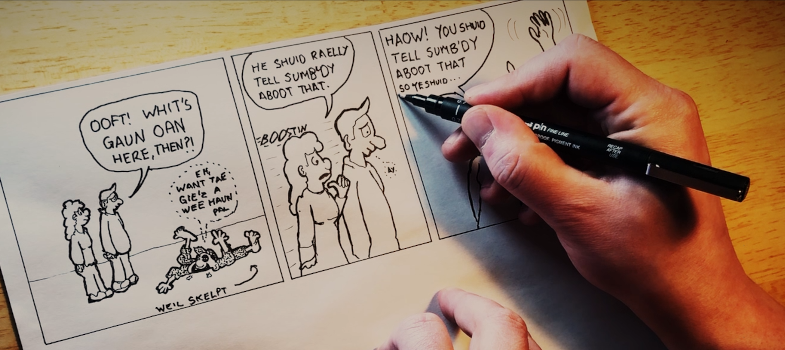Read a passage in Eejit Street and find a particular character/story you enjoy. In that style create a new comic strip. This gives the children a foundation and some of the language ready to use.
Proper Lesson Plan for Scots Creative Writing using Eejit Street to create our own Scots Comic Strips (2nd Level)
Eeejit Street 1, 2 & 3 Comics. Blank Comic Strips.
I regularly select and read, listen to or watch texts which I enjoy and find interesting, and I can explain why I prefer certain texts and authors. LIT 1-11a / LIT 2-11a
I can select and use a range of strategies and resources before I read, and as I read, to make meaning clear and give reasons for my selection. LIT 2-13a
Children to be given copies of Eejit Street to read and enjoy.
Literacy : Listening & Talking
When I engage with others, I can respond in ways appropriate to my role, show that I value others’ contributions and use these to build on thinking. LIT 2-02a
Children will discuss their favourite story with their peers and the Scots words they found and enjoyed within the story.
I enjoy creating texts of my choice and I regularly select subject, purpose, format and resources to suit the needs of my audience. LIT 1-20a / LIT 2-20a
I can spell most of the words I need to communicate, using spelling rules, specialist vocabulary, self-correction techniques and a range of resources. LIT 2-21a
In both short and extended texts, I can use appropriate punctuation, vary my sentence structures and divide my work into paragraphs in a way that makes sense to my reader. LIT 2-22a
Children to now create their own version of an Eejit Street Comic using the Characters and Style of writing that was in the comic. They will also use the words that they have read in the comics.
Children thoroughly enjoyed reading the comics. It introduced them to some new Scots words and gave them an idea of what words meant through the pictures in the comic.
The children enjoyed creating their own comics as it was seen as a creative, arty lesson it wasn’t necessarily seen as “writing” by the children. As the focus was quite funny a lot of the Scots they already knew played into this and they were to able to apply this without being stifled into hunting the correct Scots words.
As it was also within the structure of a comic book there was less pressure on punctuation and grammar which can often cause problems in a writing lesson never mind with the nuances within the Scots language.
I would possibly link it more with the prior lesson on creating actions for a Scots song and see if the children could create their own Scots song rather than their own comic. My worry with initially doing this was stifling their creativity with children having to try and create rhymes using Scots which they may find rather tricky.
The next steps for the children will be to slowly push them into using Scots in a more formal way. The logical next step would be to turn the comic they created into a written story which means rather than simply speech being in Scots they would have to describe in Scots etc.
Scots has become a way of discussing things in our classroom and is practiced daily through discussion, presentation and simple teaching.
